How to add electronic signature to PDFs, Word and Google docs

A distinctive and professional signature can help you leave a good impression in various situations. In many ways, your signature is part of your personal brand. Developing your own distinct signature is therefore a worthwhile process, as you’re going to be using it for a very long time. In this article, we explain how to make a signature for yourself with a step-by-step process, in addition to some additional tips.
Developing your own unique signature can be an important process, but it can also be very enjoyable as you experiment with different ideas. A good signature typically has certain characteristics, and you can follow the steps below to develop your own:
1. Think about what you want it to conveyA signature is often used to conclude or initiate certain processes or arrangements. Your signature is therefore going to be used at very important moments in your life, such as signing a new employment contract, a new home or when buying a new car. Your signature is going to leave an impression, and it’s a good idea to think about what sort of impression you want to make:
Take some time to consider what you want your signature to say about you. For instance, a complex signature in an attractive style might convey sophistication, in addition to a sense of style. Alternatively, a signature that is simple, straight and easy to read could suggest that you’re straightforward, strong or honest. It’s also worth remembering that a more complex signature can be harder to forge, so it’s typically best to include some complexity into your own.
2. Look carefully at the letters in your nameA handwritten signature may be a collection of letters, but this is very much an artistic endeavour. Different letters can serve different purposes aesthetically, so take some time to consider each one and what it might look like. Many attractive signatures tend to draw the reader’s attention to particular letters. This is often the first letter of your name or surname, but it could be another. Think about which ones could be the most distinctive and how that might inform the overall style.
Some letters that are good for standing out are those that are tall, such as an ‘L’ or a ‘Y’. Certain letters can also have a unique presence when capitalised, such as a ‘G’, ‘J’ or ‘R’. Ultimately, this is all rather subjective, so use a pen and paper and experiment with the various letters in your name individually and see what appeals to you.
3. Choose what parts of your name to includeYou’ve probably noticed that many signatures differ from a person’s full name. There may be a middle name that’s excluded or replaced with initials. This is a matter of choice, but most times, you might choose to do this if a name is quite common and you want your signature to be distinctive. You may have a couple of middle names that would make your signature very long, in which case you may use initials or even excluding them from your signature altogether.
For example, your signature could be the first letter of your name, followed by your surname written in full. Alternatively, it could be the other way around. You could include your middle name in full, as a letter or exclude it entirely. You may feel that your middle name is more unique or distinctive and spell it out in full while only using a letter for your first name. Once again, experimenting with a pen and paper is typically the best way of determining what you’d like.
4. Try out different stylesOnce you’ve decided on what you’d like to include in your signature, you can think about the style of the handwriting itself. Experiment with writing it out in various forms of cursive, as blocks or a combination of the two. For instance, you could leave certain letters unconnected to let them stand out and then join the rest. Try writing it all at 90 degrees to the line and then slant the letters to varying degrees in either direction.
You can also experiment with the letters themselves. Some letters, like a lower case ‘g’ or ‘j’, have a tail that extends below the line. You can extend things like these tails to underline or even encircle other letters. This can make your signature even more unique. Try out different styles and combinations with a pen and paper, and you can also experiment with different combinations of letters and names. You may find that you want a particular style, but that this works better if you change what to include in your name.
5. Choose your favourite signatureOnce you’ve completed the first four steps, you probably have a sheet or two of paper covered in different signature variations, experiments with letters and combinations of names and letters. Aside from being an enjoyable exercise, this presents you with plenty of options. Look at the variations you’ve produced and choose the one that you like the most. You may find it beneficial to choose your favourite and then modify it or develop it a little further.
Tips for writing and using your signatureYou may use your signature in a variety of circumstances, and there are some ways you can both improve the look of your signature and find additional uses for it. Below is a list of tips regarding the use and development of your signature:
Seek inspiration from othersLike many creative endeavours, it can be a good idea to search for famous or distinctive signatures. Authors, famous politicians and celebrities often have distinctive and well-known signatures, and looking through some of these can inspire you. You may find that a particular author’s signature is a unique arrangement of their initials with no words actually spelt out, or that a famous leader’s signature may centre around a single letter, and that the rest is virtually illegible. Think about what these signatures say about them and consider this when thinking about what you want your signature to convey.
Learn some calligraphyCalligraphy is the art of handwriting, and learning even some basics can help you design a much nicer signature with a distinctive look. You might only need to take a class or two, or you might find that it’s helpful to keep learning. It may even turn into a new hobby. If you value your signature and what it does for your personal brand, the time invested in calligraphy classes may be worth it, in addition to being quite enjoyable.
Use it for digital documentsSome contracts and documents may request an electronic signature online. Certain file types, like PDFs, can include a version of your signature in digital form. Typically, taking a photograph of your written signature and uploading it to the software and using software applications to transfer your information. You can also use an electronic signature as a digital ‘stamp’ for signing documents. In many cases, this is legally binding in the same way that a physical signature is. You can also use this digital signature for cover letters, CVs and even at the bottom of emails.
Update your signatureYou can also change or update your signature if you’re dissatisfied with the current version. You might have changed your mind or had an idea that you want to implement. Typically, there’s no reason to hesitate, as a signature is an important and personal thing. Consider checking with your bank and any other services that rely on your signature to make sure that there are no issues with your new one.
What is electronic signature?

An electronic signature is the use of a digital impression, markup or element to signify that the person ‘e-signing’ agrees to the terms in the contract they’re signing. It’s distinct from what was historically called ‘wet signature’, where parties to a contract had to physically make a mark on a paper contract with a pen.
This modern approach to contract signing has been adopted in most of the world, and electronic signatures can be used to sign documents in various formats. Most commonly this includes PDFs, Word documents, spreadsheets, and of course various native browser-based contract platforms, like Juro, where contracts can be signed in seconds.
Create electronic signature
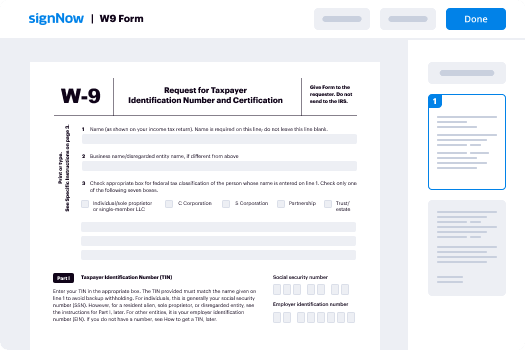
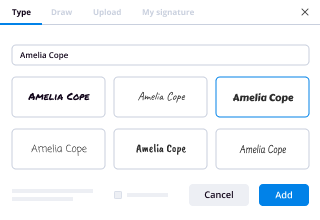
So, you need to eSign a document online? Drive your process with signNow, a perfect solution to lost time, risky security and inefficient processes. Generate your signatures online in three possible ways: draw, type in or upload an image of a handwritten signature. make electronic signature at ease.
Follow the step-by-step guidelines to creating an electronic signature online:signNow supports almost every format: PDF, Word, etc. Apart from signing a document, you can fill it out by adding a variety of fields: text, date, dropdown. Send a doc for signing via email, SMS or with a public hyperlink. Set-up Bots that’ll remind a signer to verify the file and inform a sender as soon as it’s signed. how to create your signature effectively straight away.

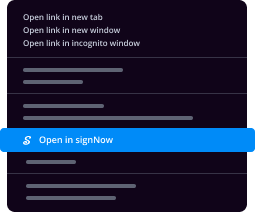
Google Chrome features multiple advantages that users can’t ignore, making it the top browser across the US. For instance, it’s the number one browser for its speed and library of extensions. With Chrome you can synchronize bookmarks, history and settings across all of your devices. To sign a document in Google Chrome, search for the signNow add-on in the Web Store and download it. make electronic signature without buying software.
Close deals in Google Chrome:The add-on helps streamline the signing process without the need for additional software. It is compatible with major platforms (Mac and Microsoft windows) and advantages customers by offering a fast, secure and efficient eSigning experience without having leaving your Google window. how to create your signature advantageously.
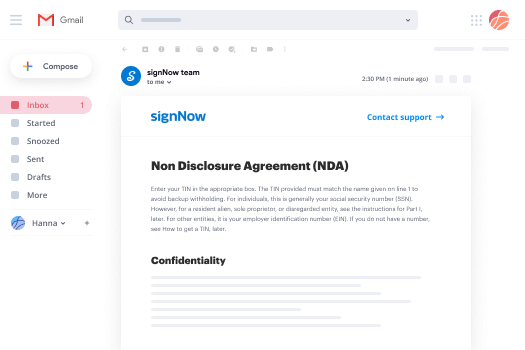
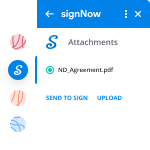

If you’re someone who already loves the experience signNow delivers, you’re in for a treat. Raise your hand if you find it time-consuming and inconvenient to switch from your Gmail to your signNow account to sign documents. Guess what. Now, get an impactful new way to eSign right from your inbox. make electronic signature for the first time right from the message you received with the attachments that need signing.
creating an electronic signature in Gmail:signNow is one of the leading eSignature solutions on the market. It’s always developing and improving its functionality to meet your most sophisticated requirements. The integration with Gmail allows users to easily, effectively and safely manage eSignatures. Save time and how to create your signature in a few minutes.

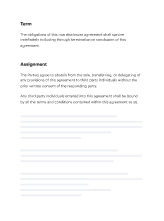

In the era of the digital revolution and instant messaging, users can manage and sign documents on the go via eSigning applications for smartphones and tablets. signNow packs two powerful apps, one for iOS and another for Android for generating signatures and to make electronic signature forms.
Taking mobile signatures to the next level:The signNow application allows you to sign documents while offline. Once you regain internet access the files you executed will automatically send the recipients they’re intended for. signNow can be a useful app that can help users to how to create your signature and keeps document workflows running efficiently.
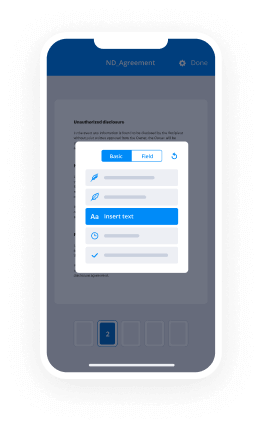

Source:
https://uk.indeed.com/career-advice/career-development/how-to-make-a-signature
https://juro.com/learn/electronic-signature
https://www.signnow.com/esignature/how-to-create-your-signature



